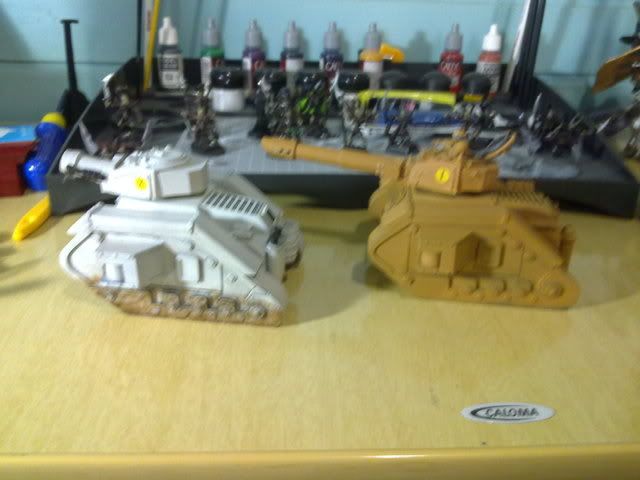I said I was going to try and create a posting routine and since today deserves a post I had to come up with something that I'll be able to keep up for the following weeks, so here is "Friday's Tank 101", where I'll address some basic concepts about painting all sorts of Vehicles, and not only tanks as the title may imply. Let's begin then.
There are plenty of details that make or break a vehicle paint job but these first steps are the cornerstones of a good looking model. Today we give our salute- to Primers. But we will talk about a specific type of primer.
The Primer
Bad application of primer will destroy the tank making either too hard or impossible to get a good final piece. There are so many things that can go wrong with the primer (believe me I've experienced a lot of bad things with primer). It can be too thick, it can leave brushstrokes, it can be spoiled and deliver a bad finish or maybe it won't stick or dry. That's why choosing a good primer is essential for achieving a good piece.
My father in law was on the business of painting motorcycles for about fifteen years and when I started whit the hobby he gave me a lot of tips. The best one was to use Polyester Automotive paint as my primer and undercoat.

Now, why should you use automotive paint on your Leman Russes, Land Raiders or even as a primer for your models? I mean, they are only soluble in thinner, have a rather strong smell and have to be applied with an airbrush, so what's the advantages of it?
For those of you who live where you can get a can of army painter for a few bucks this may go under the radar but where I live I have to pay almost 7 usd for a small 17ml bottle of Vallejo paint, so price is an issue. A half-gallon of automotive paint normally goes for 15 usd and after diluted you end up with over four times the amount you had without losing any coverage!
As they are intended to be used in a professional work they will indeed achieve a professional finish very easily. They leave an extremely thin layer and even when applied for the first time and with no experience you will get a wonderful result. I can assure you that no details can ever be lost when using it, I mean, unless you dip the model on the paint that is.
For example take the right tank on the bottom picture. Its a scratchbuilt tank that was handed to me on the plastic, as since it was so inexpensive I decided to try this paint for the first time. Note, that was the first time I was using an airbrush and this kind of paint so I was expecting to mess things up.

The end result was this, a nicely primed tank. I used the base coat color since I knew nothing about pre-shading at that time but even so it
worked very well.

Also, they are very resilient, as they are intended for outdoors, and they will not peel off the model ever, even when exposed to harsh conditions, say like carrying a just primed tank on a backpack without protection. This happened to me yesterday and the tank has no paint chip on it, it's amazing.
The only thing to look out for is that thinner. I'm not talking about the smell nor the dangers of inhaling it, but since the paint have to be so much diluted to be used on an airbrush you may end up putting too much thinner and that may be bad for your plastic models. That's very hard to happen but the second time I used it I lost a Termagant, he looked like he was hit by a melta shot! So, until you have some experience I would advise you to test the recently diluted paint on a sprue piece.
It was brought to my attention that you can get Polyester paint in a spray can, and even though my father-in-law despises it since you have no control on the application and it's way more expensive that buying it by the quarter-gallon, it's still a very good alternative.

I think this covers the Polyester paint quite well, if you guys have any questions about it fell free to leave a comment and I'll be most pleased to address it.
No comments:
Post a Comment